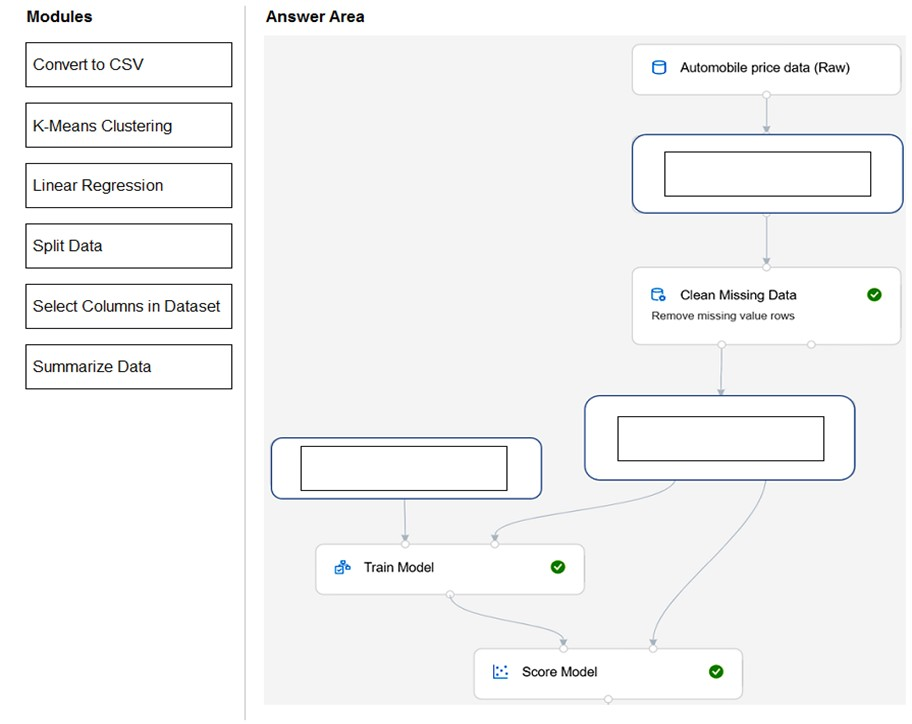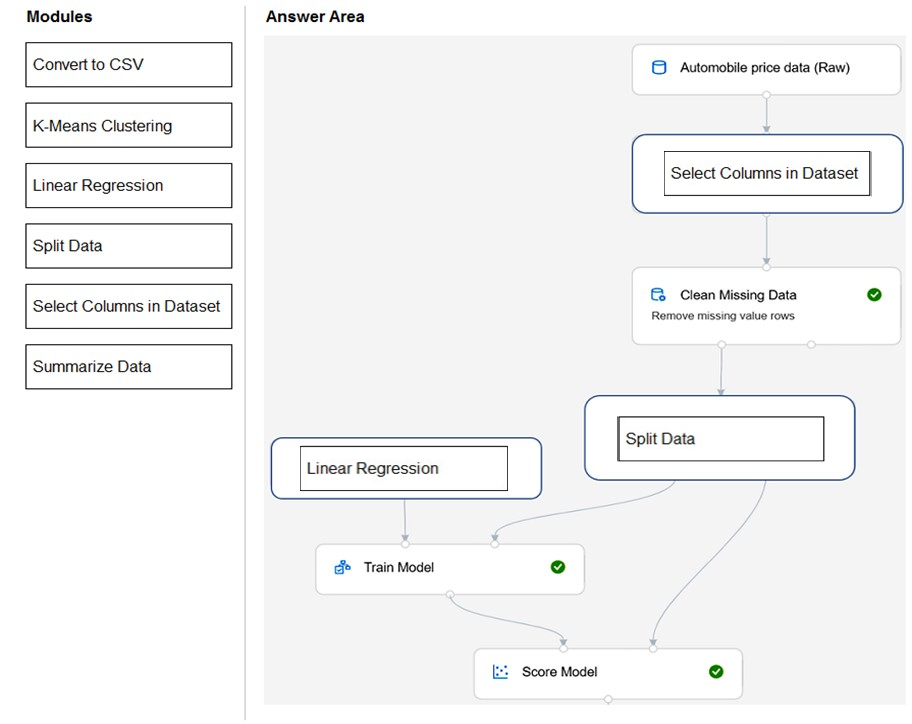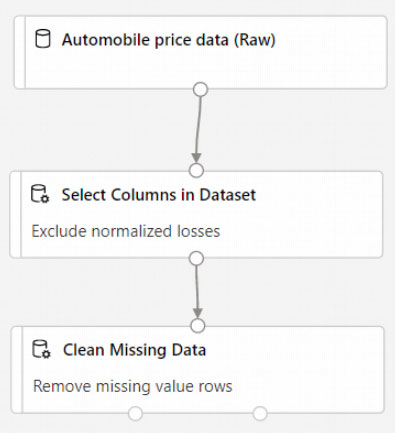DRAG DROP -
You need to use Azure Machine Learning designer to build a model that will predict automobile prices.
Which type of modules should you use to complete the model? To answer, drag the appropriate modules to the correct locations. Each module may be used once, more than once, or not at all. You may need to drag the split bar between panes or scroll to view content.
NOTE: Each correct selection is worth one point.
Select and Place:
Answer:

Box 1: Select Columns in Dataset
For Columns to be cleaned, choose the columns that contain the missing values you want to change. You can choose multiple columns, but you must use the same replacement method in all selected columns.
Example:
Box 2: Split data -
Splitting data is a common task in machine learning. You will split your data into two separate datasets. One dataset will train the model and the other will test how well the model performed.
Box 3: Linear regression -
Because you want to predict price, which is a number, you can use a regression algorithm. For this example, you use a linear regression model.
Reference:
https://docs.microsoft.com/en-us/azure/machine-learning/tutorial-designer-automobile-price-train-score
Which type of machine learning should you use to identify groups of people who have similar purchasing habits?
Answer:
C
Clustering is a machine learning task that is used to group instances of data into clusters that contain similar characteristics. Clustering can also be used to identify relationships in a dataset
Reference:
https://docs.microsoft.com/en-us/dotnet/machine-learning/resources/tasks
HOTSPOT -
To complete the sentence, select the appropriate option in the answer area.
Hot Area:
Answer:

Regression is a machine learning task that is used to predict the value of the label from a set of related features.
Reference:
https://docs.microsoft.com/en-us/dotnet/machine-learning/resources/tasks
Which metric can you use to evaluate a classification model?
Answer:
A
What does a good model look like?
An ROC curve that approaches the top left corner with 100% true positive rate and 0% false positive rate will be the best model. A random model would display as a flat line from the bottom left to the top right corner. Worse than random would dip below the y=x line.
Reference:
https://docs.microsoft.com/en-us/azure/machine-learning/how-to-understand-automated-ml#classification
Which two components can you drag onto a canvas in Azure Machine Learning designer? Each correct answer presents a complete solution.
NOTE: Each correct selection is worth one point.
Answer:
AD
You can drag-and-drop datasets and modules onto the canvas.
Reference:
https://docs.microsoft.com/en-us/azure/machine-learning/concept-designer
You need to create a training dataset and validation dataset from an existing dataset.
Which module in the Azure Machine Learning designer should you use?
Answer:
C
A common way of evaluating a model is to divide the data into a training and test set by using Split Data, and then validate the model on the training data.
Use the Split Data module to divide a dataset into two distinct sets.
The studio currently supports training/validation data splits
Reference:
https://docs.microsoft.com/en-us/azure/machine-learning/how-to-configure-cross-validation-data-splits
DRAG DROP -
Match the types of machine learning to the appropriate scenarios.
To answer, drag the appropriate machine learning type from the column on the left to its scenario on the right. Each machine learning type may be used once, more than once, or not at all.
NOTE: Each correct selection is worth one point.
Select and Place:
Answer:

Box 1: Regression -
In the most basic sense, regression refers to prediction of a numeric target.
Linear regression attempts to establish a linear relationship between one or more independent variables and a numeric outcome, or dependent variable.
You use this module to define a linear regression method, and then train a model using a labeled dataset. The trained model can then be used to make predictions.
Box 2: Clustering -
Clustering, in machine learning, is a method of grouping data points into similar clusters. It is also called segmentation.
Over the years, many clustering algorithms have been developed. Almost all clustering algorithms use the features of individual items to find similar items. For example, you might apply clustering to find similar people by demographics. You might use clustering with text analysis to group sentences with similar topics or sentiment.
Box 3: Classification -
Two-class classification provides the answer to simple two-choice questions such as Yes/No or True/False.
Reference:
https://docs.microsoft.com/en-us/azure/machine-learning/studio-module-reference/linear-regression
HOTSPOT -
To complete the sentence, select the appropriate option in the answer area.
Hot Area:
Answer:

Reference:
https://docs.microsoft.com/en-us/azure/cognitive-services/custom-vision-service/getting-started-build-a-classifier
HOTSPOT -
To complete the sentence, select the appropriate option in the answer area.
Hot Area:
Answer:

Reference:
https://docs.microsoft.com/en-us/azure/cloud-adoption-framework/innovate/best-practices/trusted-ai
HOTSPOT -
To complete the sentence, select the appropriate option in the answer area.
Hot Area:
Answer:

Reference:
https://docs.microsoft.com/en-us/azure/architecture/data-science-process/create-features